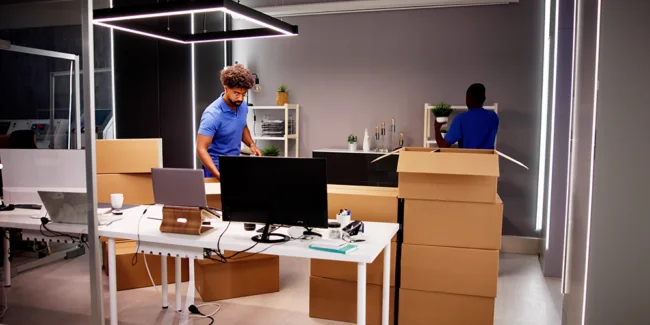Essential IT Planning Tips for a Smooth Office Move

Posted on June 26, 2025 by Louise Howland
Relocating your office should feel like an exciting step forward, not a source of stress and downtime. Yet all too often, businesses underestimate the complexity of moving their IT setup, and that’s where problems creep in.
We’ve seen it all. From phones that never ring, to emails that vanish into thin air, office moves can bring out the worst in technology. But with the right preparation, you can avoid most of the drama.
Here are some key IT planning tips to keep your move running smoothly, and to help your team hit the ground running in the new space.
Start planning early – much earlier than you think
The most common IT mistake during an office relocation is underestimating lead times. Critical services like broadband circuits or leased lines can take weeks or even months to install, especially in newly built or shared premises. Waiting until the last minute can mean arriving in your new office with no connectivity and no fallback.
Start by checking the availability of services at your new address. If fibre is unavailable, will you need a temporary 4G solution? The earlier you ask these questions, the more options you’ll have, and the smoother your move will be.
Assess your new space, not just your old setup
What works in one office may not translate to another. Wireless coverage, for example, is heavily affected by layout, construction materials, and interference from neighbouring networks. Assuming your current Wi-Fi setup will simply “plug in and go” is risky.
Consider commissioning a wireless survey before moving day. This provides a clear picture of coverage gaps or dead zones, allowing you to adjust access point placement or plan for boosters ahead of time.
Label everything, then double-check it
During an office move, it’s surprisingly easy for equipment to get mixed up. Once disconnected, server racks, switches and patch leads often look indistinguishable. Without proper labelling, reinstallation can become a tedious guessing game that delays your go-live date.
Use consistent labelling across all hardware and cabling. Document your rack layout and take photographs of your comms room configuration before dismantling anything. These small steps can save hours of troubleshooting later.

Don’t let printing become a bottleneck
Printers are often overlooked in IT planning, yet they can be a significant source of frustration during a move. Many retain static network configurations, causing conflicts or complete failures in a new environment.
Include your printing infrastructure in your move checklist. Will printers need to be reconfigured with new IP addresses? Have the appropriate drivers and permissions been tested on the new network? Addressing this in advance helps ensure your staff can print from day one.
Backups aren’t optional, they’re essential
Office moves involve physical risks. Whether it’s dropped servers, mislabelled drives, or accidental data overwrites, you need a robust fallback plan. A verified backup—securely stored offsite or in the cloud, can mean the difference between a minor glitch and a catastrophic loss.
Review your current backup regime before the move. Confirm that data is current, protected, and easily restorable in the event of damage or loss during transit.
Test before your team walks through the door
Once your systems are reconnected, set aside dedicated time for thorough testing. This includes internet access, telephony, file sharing, cloud applications and peripheral devices like printers or scanners. Even simple issues, such as a misconfigured switch port, can snowball into major disruption if discovered too late.
By testing over a weekend or before staff arrive, you avoid the chaos of troubleshooting under pressure. One hour of quiet verification can save an entire morning of lost productivity.
Don’t go it alone!
An office relocation is a milestone, but without careful IT planning, it can quickly become a setback. At ramsac, we support businesses through every phase of their move, from infrastructure audits to connectivity planning and on-site setup.
Our experienced consultants anticipate the hidden challenges that derail productivity, ensuring that your systems are live, stable, and ready to go the moment you step into your new space.
Planning a move? Let’s talk early, so you can focus on the future, not firefighting.
How can we help you?
We’d love to talk to you about your specific IT needs, and we’d be happy to offer a no obligation assessment of your current IT set up. Whether you are at a point of organisational change, unsure about security, or just want to sanity check your current IT arrangements, we’re here to help.








